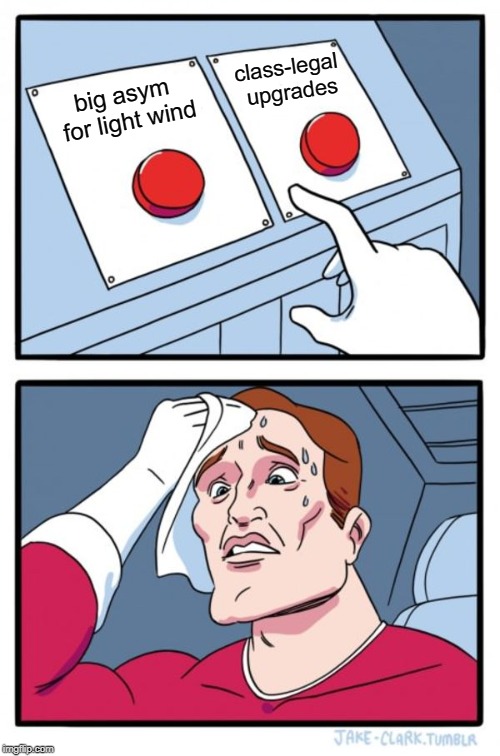Bowsprit and Code Zero
Here are a few pictures of last years biggest project (and biggest winner by far): A homemade A-frame bowsprit and a "Cruising Code Zero" on a continuous-line furler.






I'll go through the process over a few posts, just in case anyone else might be crazy enough to do something similar. But first, why did we do all that?
When we bought the boat, she came with 2 150% genoas, one that seems to be a fairly standard weight dacron (6oz or so) and the other a very light North Sails laminated sail (perhaps leftover from a previous life as a racer? We don't know her history that far back).
We mostly sail in the South Puget Sound, where summer winds are often light. So over our first couple seasons, we came to love the light 150. I have no idea what exactly it's made of, but even the slightest breeze would keep it full. It often made the difference between sailing and motoring. But after a couple seasons, it got the 'crinkle of death', and started to delaminate. I've heard from multiple sources that once these old laminate sails start to go, there's really nothing to do for them. It seemed like we could:
A) Buy stock in Bainbridge's sail-repair tape division.
B) Start looking at a new sail.
So I called up
@DrJudyB and started asking questions. It seemed like we had a couple options:
1) A new lightweight laminate 150
2) A smaller headsail and add an asym or code zero
A laminate 150 would have been ~$1200, and still leave us with our old 100% working jib for the occasions when we have a bit more breeze. The jib wasn't in terrible shape, but it has seen a lot of miles, and would probably need replacement sooner rather than later. So we'd be on the hook for $1200 now, and several hundred more later.
Cruising Code Zero
So I was seriously considering the combination of a furling jib (described above) and an asymmetric spinnaker. Judy recommended we look at their 'cruising code zero'*. It's a close-reaching sail, cut from heavier spinnaker cloth (1.5oz, whereas a C-22 reaching/running asym would probably be .75oz). Judy pointed me to some videos of her Potter screaming along under a similar sail (search YouTube for 'Little Deuce Sloop'). Hyde's standard C-22 C0 is 242 ft^2. Roughly equivalent to a 230% headsail, so quite a bit larger than even our light 150. And the combination of the C0 and a smaller genoa seemed like it would cover a wide range of wind speeds.
Furler
Finally, I noted that Defender had a small Facnor furler (FX-900) on clearance for $300 (discounted from a regular price closer to $1k). I wasn't scared of learning to launch and douse a chute, but I was pretty certain that we'd use it a lot more if it were a simple matter of unfurling. And at about the same price as a spinnaker sock, the furler seemed like a no-brainer (when I mentioned that price,
@DrJudyB said she might snap up a couple).
Important note: the flying sail furler needs to be out in front of the headstay, to give the spinnaker space to furl. Thus the need for a bowsprit, which I'll describe in more detail below.
The C0 has an integral luff of anti-torsion cable, which you need to transfer the furler's torque evenly up to the top swivel. And the price was very reasonable, at $891 (shipping included). With a sprit out front, our sail is about 278 ft^2, so about 15% larger than the stock size, but HSD didn't charge us any extra for the additional material (we did pay an extra $45 for a 4-color design; the standard price covered up to 3 colors).
* (Judy did note that calling it a C0 is a bit confusing, since that's often a very specific racing sail, and this one is cut somewhat fuller for cruising - but it's hard to think of a better name).
Cost: ~$1700 (ouch, don't tell my wife!)
* Sail: $936 (including the $45 charge for a fourth color)
* Sprit: ~$250
* Furler: $311 with shipping
* Furling line, fairleads, etc: Approximately $30
* Sheets: $83
* Sheet blocks: $32
* Halyard + blocks: ~$60
Time:
Building and mounting the sprit: 30 hours
Installing furler, furling line, halyard, etc.: 10.5 hours
About 10 hours of that time was installation of the sprit, so I think using a commercial sprit would have saved ~20 hours (and cost an additional $1-2k). It would be lighter, and probably stronger, but also not nearly as satisfying.
PS: Don't tell
@DrJudyB, but when the C0 arrived, it even included a nice launch bag that I don't recall paying extra for.
















